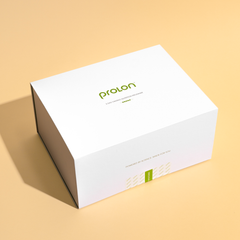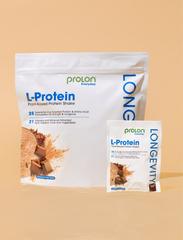
What No One Tells You About Ozempic
The world has been taken by storm with the launch of Ozempic, an injection created to help manage blood glucose in people with Type 2 Diabetes. Most people taking the drug report losing anywhere from 5% - 10% of their total body weight. *Queue: everyone, everywhere wanting “in” on this “quick fix” weight-loss drug.
But is Ozempic really as magical as it seems? Also, how does it stack up against other programs like ProLon when it comes to glucose management and weight loss? Let’s peel back this layered onion together.
First, a bit of science (as we do): the Ozempic drug falls under a class of medications known as a semaglutides which work by mimicking a hormone called glucagon-like-peptide (GLP-1). GLP-1s like Ozempic and others like Wegovy, stimulate the release of insulin after you eat, which increases your body’s ability to use glucose as energy. It also reduces the production of new glucose in the liver.
All of this seems great on paper, but with so many people now turning to Ozempic for weight management, the drug’s risks are now becoming more apparent and problematic. In fact, some of the very reasons people choose to take Ozempic are the very real problems related to its use.
On the one hand, Ozempic suppresses your appetite. This is good, right? Not exactly. Many people report only eating one full meal a day. While reducing your caloric intake can support weight loss, limiting the amount of food you eat also increases your chances of not eating enough of the essential nutrients you need. When compounded over time, this makes a person more susceptible to harmful nutritional deficiencies (like reduced vitamin and mineral intake) that can lead to more problematic conditions in the future. Even more problematic, the weight loss most people experience is not just fat loss. In fact, reports show that nearly 40% of the weight a person loses is from total muscle mass, our lean body tissue. The loss of muscle mass is not just concerning in terms of overall strength, but it will also negatively impact their metabolism over the long run. So much so that loss of muscle mass can significantly reduce your resting metabolism (otherwise known as your Basal Metabolic Rate) making it easier – and more likely - to gain weight after stopping the drug. And unlike body fat, gaining back muscle strength is much harder to do once it’s been lost. This can – and will - set you up for weight gain and metabolic issues in the future.
Ozempic reduces overall cravings. Again, this sounds really nice, right? Not so fast... Ozempic reduces cravings by suppressing certain neurotransmitters like serotonin and dopamine after eating food, the chemicals that make us feel excited and happy after eating food. Serotonin and dopamine also happen to be necessary for maintaining proper circadian rhythms, which regulate our sleep and wake cycles. While insomnia is not listed as a direct side effect of the drug, many people have reported experiencing sleep issues, likely due to the drugs impact on these neurotransmitters. Additionally, people report increased anxiety while taking the drug, also a result of reduced dopamine and serotonin production. Not fun.
The drug also slows gastric emptying. This means that food stays in our stomach much longer than it normally would, which is partly why a person will feel full. We like feeling full and satiated right? Well, for some people, this can make them feel nauseous, a common side effect of the drug. The slow gastric emptying is also arguably the most dangerous of the drug’s effects. In some rare cases, gastroparesis has been reported, a condition in which the stomach is paralyzed and doesn’t empty at all. This can lead to significant GI inflammation and other complications. A lesser-known fact, for anyone on Ozempic who requires surgery whether that be elective or not: Ozempic use can increase a person’s risk of aspiration when under anesthesia. Many anesthesiologists have reported higher incidents of life-threatening aspiration due to Ozempic, and most require patients coming in for surgery to discontinue the drug for at least a week to reduce this risk.
While Ozempic might be lifesaving for some people who are morbidly obese or at extremely high risk for heart attack, for instance, it is not be a safe option for everyone. In fact, there are safer, easier, and more effective weight loss options that exist. Even certain supplements like Berberine or Siberian Ginseng can help managing blood glucose levels in a safer way. But from a whole-body perspective, ProLon is the superior option that provides all of the benefits of a drug like Ozempic, plus oh, so much more.
Here’s why:
- ProLon preserves muscle mass and overall metabolic profile. While GLP-1 reduces muscle by almost 40%, this same lean body mass is preserved when following ProLon. In fact, because of ProLon’s ability to preserve muscle by providing essential proteins, a person can jump into ketosis much faster than other forms of fasting or diets. Not to mention, your metabolism due to the preservation of muscle mass is largely protected after the program is over.
- ProLon also supports rapid weight loss. Because the program provides specific nutrients, some of the weight a person loses is from visceral fat, the type of fat responsible for poor health outcomes.
- ProLon improves overall cardiometabolic markers. Studies show that ProLon improves overall cardiometabolic markers like reduced LDL, cholesterol, triglycerides. It also has shown to reduce A1C by an average of 1.4 points, making it effective at improving insulin sensitivity.
- ProLon improves food behavior. Many people who follow the program report reduced sugar cravings and becoming more mindful of their food choices. These lifestyle changes are critical to long-term, sustainable change.
- ProLon has no known serious side effects while following the program, and no side effects that persist after the program is completed. GLP-1s have been shown to negatively impact the digestive system, leading to conditions like pancreatitis and gastroparesis, ProLon has zero side effects. Following our program is safe for most people, even some at risk populations including cancer, autoimmune disease and more.
- ProLon is far less expensive. Let’s address the elephant in the room. Ozempic can cost upwards of $800 each month for weekly injections. ProLon is $190 and only requires 5 days of your time. This is a huge financial difference.
If you are looking for health and weight support that is sustainable and long-lasting, ProLon is a safe, cheaper and more effective solution for most people. To learn more about our 5-Day program, click here.












